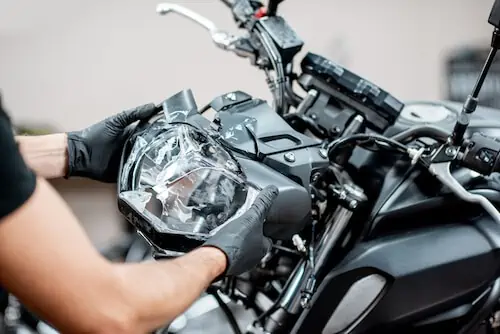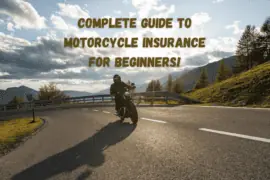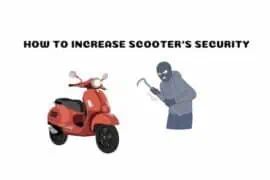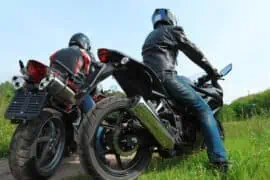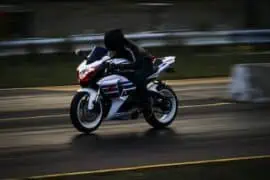Motorcycle drops can happen because of rider error, an accident in a parking lot, or equipment failure.
When this issue happens to your bike, you’ll want to take a few steps immediately to protect your investment.
Didn't You Try Our Quote Comparison Tool Yet? Save BIG by Doing it!
Table of Content
What Happens When You Drop a Motorcycle?
When you drop a motorcycle, sometimes it is fine. You can pick it up, get everything running, and ride away.
There are also times when dropping a motorcycle means you’ll need a tow to your trusted mechanic or a shop covered by your insurance if you’re out of state.
If your bike was on its stand, it and your mount are likely damaged. Since the shifter and clutch are on that side, you’ll need to check the shift peg and lever to ensure they’re not broken. Some designs can push the shifter peg into the engine case.
Motorcycles that fall in the other direction leave the brake pedal and front lever exposed. These can bend or break when the bike gets dropped. There is also the risk that the pedal could impact the engine case.
If you inspect the motorcycle and see damage to the engine case, you should not ride it from the scene. The risk of oil loss is high unless the issue involves light scratching, which means you could ruin the engine.
Don’t Forget to Check Your Foot Pegs After a Drop
Footpegs typically bend a bit on the side where you’ve dropped your bike. The issue is usually minor, requiring a quick reversal of the momentum that caused the problem.
Some motorcycles come with cast metal pegs. These can break when a bike gets dropped.
You don’t want to rely on a cracked peg when you might need to put all your weight on them during your ride.
Check the Motorcycle’s Mirrors Before Leaving
Another issue that happens with a dropped motorcycle involves the mirrors. If this component is broken, your integrated turn signals might not function as expected. Repairing this problem can be expensive, which is why it helps to have insurance that covers this damage.
Mirrors affixed with fairing mounts typically have their points damaged when dropping a motorcycle. Give these a quick inspection before leaving.
Does Dropping a Motorcycle Destroy It?
Most motorcycles receive cosmetic damage when they get dropped. This issue is easy to repair, so it doesn’t impact your ability to ride the bike.
If you drop a motorcycle on a soft surface, you might not have any damage occur.
When it goes horizontal while traveling at high speed or on a stand, there is a risk that the engine case could be compromised. A thorough inspection is necessary before riding the motorcycle. If you’re unsure, have it towed to prevent further problems.
How to Prevent Dropping a Motorcycle?
Most riders have dropped a bike at least once. Practice and technique are what prevent a motorcycle from going horizontal. When you master these tips, you’ll avoid most of the mishaps leading to dropping yours.
1. Maintain Speed
The combination of inertial force and gravity keeps a motorcycle stable. When your speed decreases, so do those factors. Even a little extra can improve the overall riding experience, although you’ll need to lean more when attempting a slow turn.
2. Square Up
A common reason for dropping a motorcycle is to slam on the brakes while the handlebars are turned. Try to straighten everything as you apply the bike’s stopping power, ensuring you’re in a square position while rapidly slowing.
3. Eyes Up
Many beginners tend to look downward when riding a motorcycle, especially when they start slowing or stopping. Try to keep your eyes on the horizon, or at least on the vehicles in front of you, to avoid potential hazards.
4. Consider the Footing
Slippery surfaces reduce traction under the tires and your boots. Certain areas are prone to hazards, such as parking lots and intersections. As you start pulling to a stop, look for any potential problems that could cause you to lose control.
Your boots or shoes should have oil-resistant tread to minimize losing traction when stabilizing the equipment with a foot.
5. Use the Stand
Forgetting to lock the side stand can cause a bike to tip quickly, ruining those custom finishes and chrome parts. Please take a moment to ensure it’s in the correct position and fully extended. From there, slowly lower the weight onto the surface before getting off the motorcycle.
If you park on hot asphalt, the side stand could sink into the surface. Place a flat object underneath it to disperse the weight more effectively.
6. Remove the Lock
Disc locks can prevent someone from stealing your motorcycle. It can also cause you to drop the bike when you’ve forgotten to remove them before throttling the engine.
Try locating the lock close to the caliper to prevent more than a few inches of the roll. Then add a reminder that the lock is still in place, like a flag or marker on the handlebar.
Some of today’s best disc locks come with an alarm warning you to remove the item before riding away.
7. Use the Rear
Slow-speed braking should focus on the rear instead of the front. If you introduce too much stopping power, it’s much easier to create a sudden stop that catches you off guard. Most motorcycles use an integrated system where the rear pedal activates the front, making this tip impossible to apply, but some models have this option.
When you’ve dropped your motorcycle, the first step is to assess yourself for injuries. If you’re okay, then evaluate the bike. Your insurance policy might cover damages in these circumstances, so document the event thoroughly before starting the claim paperwork. There might be a deductible to pay, and your rates might rise, so you have the option for out-of-pocket repairs.
Use This Tool for Free and Save on Quotes!


